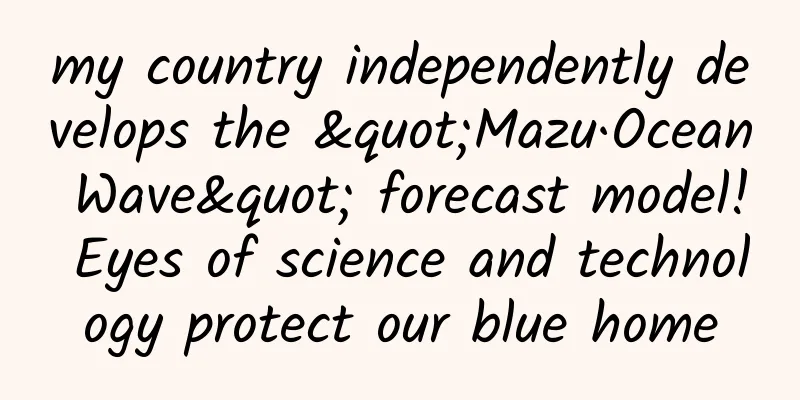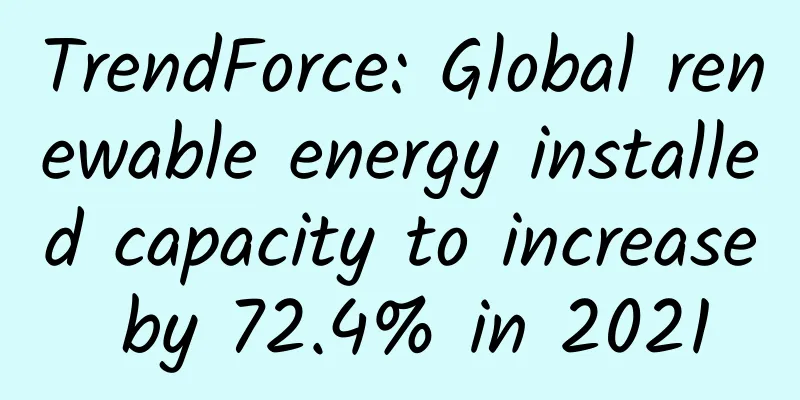my country independently develops the "Mazu·Ocean Wave" forecast model! Eyes of science and technology protect our blue home

|
Produced by: Science Popularization China Author: Zhou Zhou (Dalian University of Technology) Producer: China Science Expo Editor's note: To showcase the latest trends in intelligent technology, the China Science Popularization Frontier Technology Project has launched a series of articles on "Artificial Intelligence" to provide a glimpse into the latest progress in artificial intelligence and respond to various concerns and curiosities. Let us explore together and welcome the intelligent era. Recently, according to a report by China Daily, it was learned from the Ministry of Natural Resources that the "Mazu Wave" forecast model independently developed by the National Marine Environmental Forecast Center has been successfully applied many times, ensuring the smooth holding of major events and effectively promoting early warning of wave disasters. Origin of the name In the vast ocean world, the ups and downs of the waves often hide unknown risks and opportunities. In order to better understand the mysteries of the waves and protect the safety and interests of human beings in marine activities, scientists have continuously explored and innovated, and developed advanced wave forecasting models, among which the "Mazu Wave" forecasting model is a shining pearl of science and technology. She is like a pair of bright eyes, leading humans to understand the mystery of the waves. The "Mazu·Waves" forecast mode has a unique and meaningful name. Mazu, as a sea god widely respected in China's coastal areas, symbolizes protection and peace; while waves represent the most dynamic and changing force in the ocean. Combining the two not only reflects the awe and respect for the ocean, but also contains the beautiful vision of protecting the ocean with the help of scientific and technological power and ensuring the harmonious coexistence of humans and the ocean. The waves contain endless power (Photo source: veer photo gallery) The magic of fine grids and multi-factor considerations In order to achieve accurate forecasts, advanced wave numerical forecasting models often use high-resolution computational grids, which can be imagined as using a finer net to capture subtle changes in the ocean. The finer the grid, the more accurate the numerical value is in describing the complex terrain, currents and meteorological conditions in the ocean. This computational grid generation technology is widely used in meteorological or ocean forecasting models. It is particularly worth mentioning that when collecting and analyzing ocean observation data, a wide range of data collection channels are used to achieve accurate results. For example, a large number of buoys and observation stations are deployed in the ocean, which can measure key parameters such as wind speed, wind direction, air pressure, ocean temperature, wave height, etc. in real time, and transmit the data back to the data center; they can also obtain large-area ocean surface information through various sensors carried by satellites, including sea surface temperature, current speed, wave characteristics, etc.; and passing merchant ships, scientific research ships, etc. conduct observations during the voyage and record relevant ocean and meteorological data. At the same time, there are large-scale numerical weather forecast data from the meteorological department. The ocean radars installed in coastal areas can monitor the nearshore wave conditions and use acoustic principles to measure physical parameters in the ocean... These data are like pieces of a puzzle, providing the initial basic information for the model. Seaside observation point (Photo source: veer photo gallery) Generally speaking, the specific application steps of computational grid generation technology are as follows: Determine the requirements: According to the scope of the forecast area and the required accuracy requirements, the overall layout and resolution of the grid should be clarified. This requires comprehensive consideration of the complexity of the marine environment and the specific forecast application requirements. Observation stations distributed in Bohai Bay (Image source: Reference 2) Divide cells: Use advanced numerical algorithms and model building techniques to divide the forecast area into a series of regular or irregular cells. During the division process, the size and shape of the cells will be adjusted according to factors such as the topography, currents, and meteorology in the ocean. For example, in areas with complex ocean topography, drastic current changes, or special meteorological conditions, the cells may be divided into smaller units to more accurately simulate the changes in these areas. Consider key geographic features: Pay full attention to key geographic features in the ocean, such as coastlines, islands, trenches, etc. For areas close to these features, further refine the grid to make it finer. This can more accurately describe how the marine environment changes near these special geographical locations. Using grids to identify specific geographic features (Image source: Reference 1) Adopting multi-layer nested grid technology: To improve computational efficiency and accuracy, we use multi-layer nested grid technology. That is, on the basis of a large-scale low-resolution grid, we embed a higher-resolution grid for the local area of focus. This can ensure computational efficiency while performing more detailed simulation and forecasting for specific areas. Optimize grid: Use optimization algorithms to optimize the grid to reduce calculation errors and improve simulation accuracy. By continuously adjusting and improving the distribution and parameters of the grid, it is more in line with the characteristics and physical laws of the actual ocean environment, thereby improving the accuracy and reliability of wave forecasts. Using the model input data to make predictions (Image source: Reference 1) From a popular science perspective, the "Mazu Waves" forecast mode is like an intelligent ocean current predictor. It can "learn" the patterns of ocean flow and "remember" these patterns so that at a certain point in the future, given the current state of the ocean, it can accurately predict the direction of the current. This is like an experienced captain who, by observing changes in the sky and the sea, can predict the weather and currents and make the best sailing decisions. Outstanding performance beyond tradition The "Mazu Wave" forecasting model has significant advantages over traditional wave forecasting methods, which often rely on empirical formulas and simple statistical models with limited forecast accuracy and temporal and spatial resolution. The "Mazu·Wave" mode can do a lot: first, the advanced hexagonal grid and dynamic framework can obtain high-precision forecast results in key encrypted sea areas and high-latitude waters in the Arctic and Antarctic; second, the efficient convolution wave nonlinear action algorithm can improve its computing efficiency by one third; third, excellent large-scale parallel scalability, which can carry out ultra-scale parallel computing of 130,000 CPU cores; fourth, the leading GPU parallel acceleration capability, the computing power of a single GPU server is equivalent to 90 CPU servers, and the computing energy consumption is reduced by about 88%. Magical assistance in multiple fields The Mazu Wave Forecast Model has a wide range of applications. It is a solid shield for marine engineering - accurate wave forecasting is crucial for the design, construction and operation of offshore platforms. It can help engineers evaluate the impact of waves on platform structures, reasonably design protective measures, and ensure the safety and stability of the platform; it is safe navigation in the shipping industry - knowing the wave conditions in advance can optimize route planning, avoid ships sailing in severe sea conditions, reduce navigation risks, and improve transportation efficiency; it is the secret to a good harvest in the fishery - choose suitable fishing grounds and operating times according to the wave conditions, increase the catch, and ensure the safety of fishery production; it is also a close partner for coastal tourism - tourist attractions can take safety precautions in advance according to forecasts, remind tourists to pay attention to wave risks, and arrange water activities reasonably. Accurate wave forecasts provide more convenient fishing conditions (Photo source: veer photo gallery) At the same time, accurate wave forecasts can also provide the best time and place for water sports enthusiasts such as surfing and windsurfing, enhancing their sports experience. The difficult journey behind R&D However, the development of the "Mazu·Ocean Waves" forecasting model was not achieved overnight. It is the result of the hard work and wisdom of many scientific researchers. During the development process, researchers faced many technical difficulties and challenges. For example, how to improve the adaptability of the model to complex marine environments, how to process massive amounts of observation data and calculation results, how to verify and improve the forecast accuracy of the model, etc. In order to solve these problems, the scientific research team continuously carried out technical innovation and optimization, carried out a large number of numerical experiments and field observation verification, and gradually improved and enhanced the performance of the model. In order to ensure the accuracy and reliability of the "Mazu·Ocean Waves" forecast model, strict verification and evaluation work is essential. Researchers will compare and analyze the forecast results with actual observation data, calculate error indicators, and evaluate the performance of the model under different sea conditions and seasonal conditions. Through continuous feedback and improvement, the forecast accuracy of the model can be continuously improved. At the same time, in order to allow more people to easily obtain sea wave forecast information, relevant departments have also established a complete information release platform and service system. Through websites, mobile applications, radio and television and other channels, sea wave forecast products are released to the public in a timely manner so that people can prepare for the response in advance. With the official approval of the Ministry of Natural Resources, the "Mass Conservation Ocean Circulation Numerical Model 'Mazu 1.0'" (English name: Mass Conservation Ocean Model, referred to as MaCOM1.0) independently developed by the National Marine Environmental Forecast Center (Tsunami Warning Center of the Ministry of Natural Resources) was officially released on December 29, 2021. (Photo source: National Marine Forecasting Center) Eyes of technology, blessings of the ocean During the impact of Super Typhoon Gemi in 2024, the "Mazu·Wave" model independently developed by my country was used for wave warning for the first time, providing important support for timely and accurate warning of waves. With the continuous advancement of science and technology and the rapid development of the marine economy, the "Mazu·Wave" forecast model is also constantly evolving and improving. In the future, it is expected to be deeply integrated with emerging technologies such as artificial intelligence and big data to further improve the accuracy and timeliness of forecasts. At the same time, as the impact of global climate change on the marine environment becomes increasingly significant, the model will also play a more important role in responding to extreme sea conditions and marine disaster warnings. I believe that in the future, this technological eye will continue to illuminate our path with the ocean, help humans and the ocean coexist harmoniously, and jointly write a new chapter in blue development. References: 1. 2.Cifu Fu;Jie Xiong;Fujiang Yu.Storm surge forecasting based on physics-informed neural networks in the Bohai Sea[J].Journal of Physics: Conference Series,2024,Vol.2718: 012057 |
>>: How was China’s “Plant Pompeii” “built”?
Recommend
Case study: How to make information flow advertising in the beauty industry more effective?
Women love beauty, forever Regarding why women lo...
5 ways for educational institutions to monetize live streaming in 2021
Live streaming sales have been popular from 2020 ...
After getting a new phone during the New Year, what should I do with the data on my old phone?
After buying a new phone during the Spring Festiv...
It's this again! Another fire caused by charging an electric car indoors! How to eliminate safety hazards?
Recently, Qingpu District, Shanghai Before an emp...
How much does it cost to customize the Wenzhou e-book mini program?
WeChat Mini Program is an application that users ...
These 8 growth hacking cases will help you burst out inspiration and leverage users
Growth is like a sword of Damocles hanging over t...
Shaoxing Shengzhou pilots 4.5-day flexible work system (full text)
Shaoxing Shengzhou pilots 4.5-day flexible work s...
The must-read social media operation secrets
Community operation is an advanced form of user o...
When you feel like you can’t hold on any longer, please read this article! (I recommend everyone to read this)
Experts in this article: Wang Guixia, Lecturer, A...
How can I improve the rating of my Kuaishou store? How to improve the rating of Kuaishou store
This article mainly introduces how to improve the...
How to refine bidding promotion accounts and improve promotion effects!
When we do promotion, the proportion of bidding p...
Science cover: 20 years later, the Human Genome Project is finally complete
This Friday, the latest issue of Science magazine...
Have you done 2 hours of outdoor activities every day?
In recent years, the incidence of myopia in my co...
Top 10 Core Data tools and open source libraries loved by developers
Core Data is a great choice for storing and query...
Beijing Film Festival will be held on August 22 (with original text)
The 10th Beijing International Film Festival will...









